Samsung Galaxy Tab 10.1 Review: The Sleekest Honeycomb Tablet
by Anand Lal Shimpi on June 13, 2011 5:07 AM EST- Posted in
- Tablets
- Samsung
- Tegra 2
- Galaxy tab 10.1
- Android 3.1
- Mobile
- NVIDIA
Performance
Given that the internals are no different from other Honeycomb tablets, the Galaxy Tab 10.1's performance is unsurprisingly pretty similar to other Honeycomb tablets running Android 3.1. There are always minor variations between platforms, largely due to the difference in software preload and number of background tasks that can't be killed but for the most part these devices perform similarly with similar hardware/software.
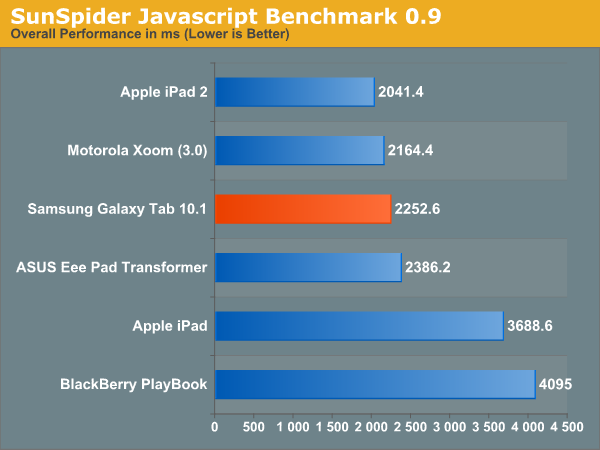
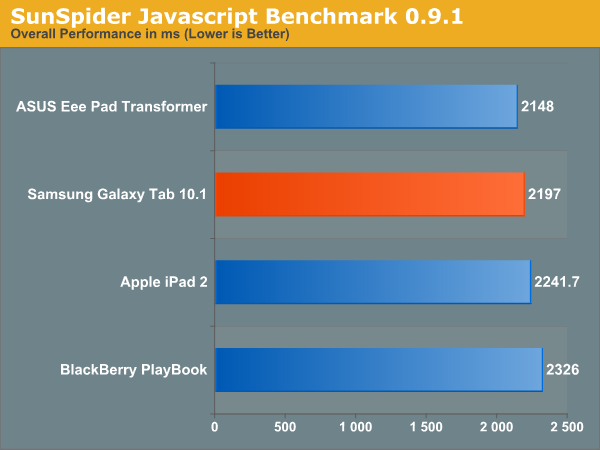
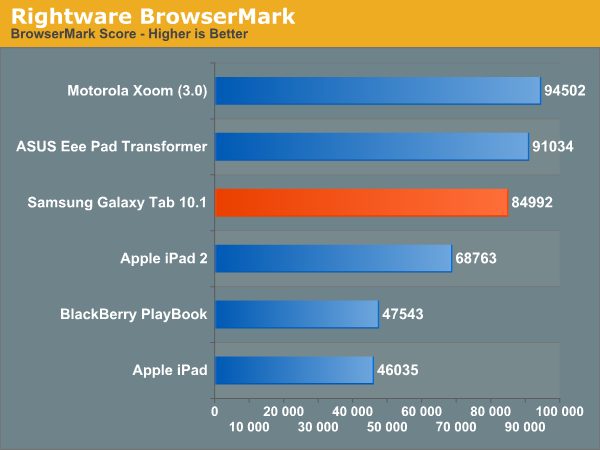
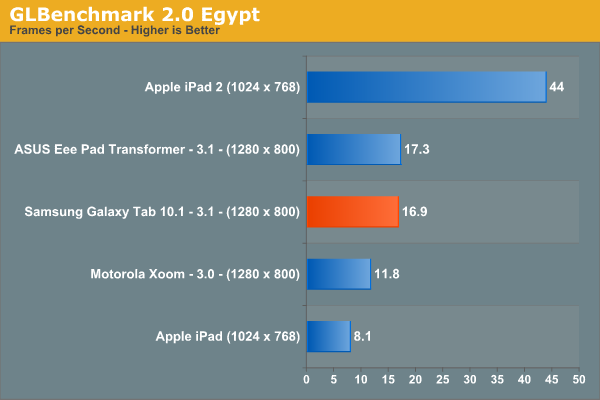
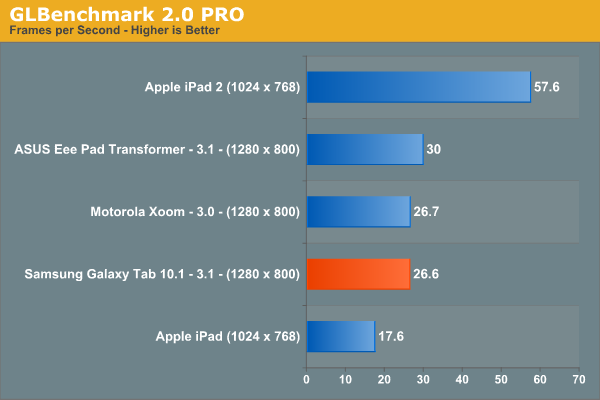










108 Comments
View All Comments
Rick83 - Monday, June 13, 2011 - link
At least slowly those prices are coming down. I was ridiculous when these things where introduced at laptop-prices instead of netbook-prices.With IPS screens, they're slowly coming into a reasonable price point.
I'm waiting for the next Archos announcement though, especially because I am looking to replace a pocketable/portable tablet and not one of these living room ornaments.
solipsism - Monday, June 13, 2011 - link
"The Galaxy Tab 10.1 measures just 8.6mm thick, [0.2mm] thinner than the iPad 2."robco - Monday, June 13, 2011 - link
I still can't really find a use for a tablet at this point, but this one looks nice. My primary concern would be if the app gap has narrowed since the Xoom was released. Also it doesn't appear that any other manufacturer's have had Apple's success in decoupling the 3G/4G versions from service contracts (without paying a lot more). It also appears that there's lots of optimization to be done. My other concern would be regarding Samsung's history when it comes to OS updates. I would hope owners won't be waiting too long to receive them.Still it's good to see competition for the iPad shaping up. I think Honeycomb makes better use of available screen real estate than iOS does. The different hardware options are nice. But I'm more old school I guess. I would still rather have a netbook or MBA. I like having a real keyboard and touchpad.
JasonInofuentes - Monday, June 13, 2011 - link
By all accounts, frustratingly, while the number of Honeycomb apps is climbing, there's a quality gap that's more important than the quantity gap. Android staples (TweetDeck, notably) is not Honeycomb optimized and to great detriment. Watching I/O this year they made it clear that the tools are their to create great apps for the platform but developers have a challenge though in developing for two Android platforms (Gingerbread and Honeycomb), maintaining and updating those releases, and still preparing to bring their Honeycomb app to the Ice Cream Sandwich framework when it's released. I would love to hear from developers why there wasn't this sort of growing pains when Apple extended iOS to the tablet form factor. What made it so easy to turn the phone app to the tablet app? What isn't there in the Android platform?@tnofuentes
Conner_36 - Monday, June 13, 2011 - link
I would guess it has to do with the SDK Apple has. While I have not actually coded an iOS app yet, playing around in Xcode made it seem like a simple check box was pretty much the difference between an iphone or ipad app.All you need to do is mess around Interface Builder for a few minutes and everything you had for the iphone can be retooled for the ipad (provided that you used Apple APIs and don't have too many custom views).
Apple has been building and rebuilding their tools and APIs for 30 years where as Google just started.
Does that make sense to anyone?
vision33r - Monday, June 13, 2011 - link
Your comparing a company(Apple) with decades of software experience to an advertising search company. Guess who makes better software?Android wasn't even grown in house and had to be bought by Google and then for Honeycomb, Google had to introduce their own C oriented language to get away from the nasty Java apps.
Whoever thought that Java apps on a phone was a good idea back then definitely was not forward thinking and this is the reason why Android apps suck so much vs iOS apps.
Google has a lot to copy from Apple. They copied the same touch interface and general multitouch UI, they got to copy Apple's music player, and even borrowed Apple's Webkit to make Chrome.
When you look at all this then you realize that Android is a copy and hack job while other OSes like WebOS, iOS, and even WP7 performs better.
Penti - Monday, June 13, 2011 - link
You do realize that it's Nokia that made the first Webkit browser for mobile platforms right? Before Apple announced and open sourced the Webkit engine they worked porting KHTML/WebCore and KJS/JavaScriptCore to S60. So just weeks after Apple open sourced it they had a Webkit-build out. WebCore and JavaScriptCore was never closed, as they where based on GPL projects, and Google uses their own Javascript-engine in Android. Not Nitro or JavaScriptCore. Webkit truly is a collaborative effort, not some magic gift from Apple developers. For that matter the underpinnings in OS X and iOS is Mach/BSD from Carnegie Mellon University and Berkeley, much of the environment and stuff that made it successful also comes from it's NeXT days such as the heritage of the Cocoa environment, Obj-C and fat binaries which NeXT ran on four platforms in 1993. GCC was the compiler back in 1989 too.Go and troll somewhere else.
Jamestownsend - Tuesday, June 14, 2011 - link
Actually, Android's javascript engine is based on apple's work on webkit. No one cares about what Nokia did...and indeed, android is the vista of mobile platforms without the large app support. Video wallpapers, widgets, etc...and a huge resource hog...it isn't trolling to state the facts...Penti - Wednesday, June 15, 2011 - link
Actually V8 was JIT before Nitro/JSC JIT branch and JIT from the start and developed the same time based on their own design and architecture. Based on Smalltalk and PCRE. So I don't know what your smoking. Not only that, it's simply not built entirely on JavaScriptCore or Apples sources since it's BSD. They do indeed have their own assembler, compiler, garbage collector and therefor their own Javascript JIT engine.Apple does contribute but not from some black hole and they do build on Open Source and other peoples work, just as they should, but you can't credit one company for it all.
You might not care, but it's thanks to Nokia, others and them cooperating in the project you can have a decent Safaribrowser to begin with. It wouldn't been optimized for embedded/mobile platforms otherwise. Ensuring it to Apple that it can be done well. Mozilla (Gecko) on the other hand has done a lot worse on the ARM-platform. Android has had native apps for a long while, since 1.5 publically and it's not because of Dalvik or the Android/Apache Harmoney class libs they had many of their performance problems. There is nothing magical on the C side that has happened with 3.0+. It is trolling when you troll about your incorrect or made up facts.
koss - Monday, June 13, 2011 - link
Hey Anand, why are all the dimensions of the three devices (Samsung, Moto and Asus) in mm and the Ipad is in inches? I mean it's not very difficult to convert, but its a pain - open another tab, etc, etc. Would you be kind enough to convert everything in the graph in the same units, regardless inches or cm? Thanks.PS: Keep it up - one of my fav. sites ;)